Rare! CIVIL WAR DOG TAG & TINTYPE PHOTO! CALIFORNIA 100 Soldier, 2nd MASS. CAV
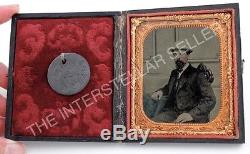
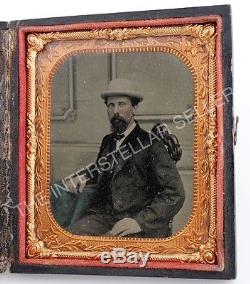

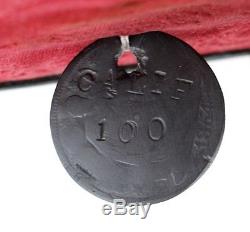
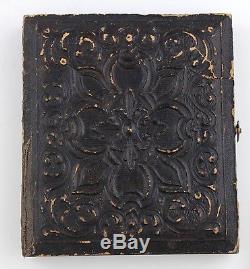

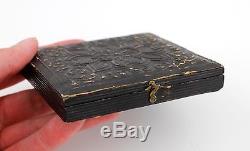


CIVIL WAR DOG TAG & TINTYPE PHOTO! CALIFORNIA 100 Soldier, 2nd MASS.
Up for sale is an. EXTREMELY RARE antique Civil War soldier dog tag and hand-tinted tintype photograph. The man is JOHN A. HILL of the California 100 , who fought with the 2nd Massachusetts Cavalry.
The tintype is nicely hand tinted, and the dog tag is made from an 1854 US coin. Only a very small number of men from California fought in the Civil War, and it is VERY difficult to find any items of theirs from the war!! And in addition, dog tags are among the most collectible Civil War items, making this a very special find indeed!
In 1862, five companies of the 2nd Massachusetts Cavalry (also known as The California 100 and the California Cavalry Battalion) were enrolled and mustered into service, and sent to Massachusetts. They left San Francisco by sea for service in the east. The California Battalion consisted of Companies A, C, F, L, and M. They participated in 51 battles, campaigns, and skirmishes! See more information and a list of these battles below!
A very rare and special piece of Civil War history! SEE OUR OTHER AUCTIONS FOR MORE!! Approximate dimensions: The dog tag measures 1 ¼ in diameter, and the photo case measures 3 x 3 ¼. Condition: Very nice overall condition. Please view the scans for additional details, and please ask any questions before purchasing.The 2nd Regiment of Cavalry, Massachusetts Volunteers was a regiment of cavalry troops in the Union army during the American Civil War. It consisted primarily of men from the states of California and Massachusetts, and served in the Eastern Theater, despite its western roots. Politicians at the start of the Civil War began raising volunteer troops in response to President Abraham Lincoln's call to arms to force the return of the Confederate States of America to the Union.
Owing to political divisions at the time of the Civil War and to the limited transportation facilities for moving troops great distances, the Lincoln administration did not request California troops for Eastern battlefields but instead called for volunteers to replace regular troops stationed at western garrisons. In the late summer of 1862, a small number of men in California who had been raised in the East decided to enlist in the army, but wanted to serve in the Eastern Theater. They contacted Governor John Andrew of Massachusetts in the late summer of 1862 and offered to raise a company of 100 cavalrymen to serve in a state regiment.
Andrews agreed on the condition the Californians would provide their own uniforms and equipment and pay for their own passage to Boston. They were designated as Company A, and soon were joined by seven companies of Massachusetts. The Californians and four of the local companies were moved in mid-February to Baltimore, Maryland, then to Fort Monroe and numerous other locations in Virginia, where they primarily engaged in picketing, scouting, and outpost duty until July 1863.
Commanded by James Sewall Reed, the Californians first took to the field near Yorktown, Virginia. From July 1863 to July 1864, the California Hundred engaged in numerous skirmishes with John S. Mosby's Confederate partisan rangers in the Loudoun Valley. In February and March 1863, another 400 Californians were recruited and sent to Massachusetts to form Companies E, F, L, and M (the "California Battalion") of the 2nd Massachusetts Cavalry.They arrived in the Bay State on April 16, 1863, completing the full complement of the regiment. They moved to Washington, D.
In August 1863, the regiment was combined in Centreville, Virginia, and became a part of King's Division in the XXII Corps. They later served in the Army of the Shenandoah under Philip H. Sheridan during the Valley Campaigns of 1864.
Among the many actions that the 2nd Massachusetts Cavalry participated in were the battles of Fort Stevens, Opequon, Tom's Brook, and Cedar Creek. The following spring in 1865, it participated in the Siege of Petersburg and the subsequent Appomattox Campaign pursuing elements of the retreating Army of Northern Virginia, then marched in the Grand Review of the Armies in Washington on May 23. The men were mustered out July 20, 1865, at Fairfax Court House, Virginia, before returning to California and Massachusetts in the weeks that followed. The regiment lost during its service 8 officers and 82 enlisted men killed and mortally wounded, and 3 officers and 138 enlisted men by disease for a total of 231.
Of the original California Hundred's 3 officers and 101 enlisted men, 40 were present the day the company disbanded. About 12 had died, others were discharged because of sickness or wounds or were transferred to other units, and 10 deserted, a greater desertion rate than from any other Massachusetts regiment. Company "A" organized at San Francisco, Cal.
Companies "B, " "C, " "D, " "G, " "H, " "I" and "K" organized at Camp Meigs, Readville, Mass. Companies "E, " "F, " "L" and "M" organized at San Francisco, Cal.
Left San Francisco for Readville, Mass. March 21 and joined Regiment at Readville, Mass.
As California Battalion April 16, 1863. Companies "A, " "B, " "C, " "D" and "K" left Massachusetts for Baltimore, Md.
Thence moved to Fortress Monroe, Va. February 12-18, 1863; thence moved to Gloucester Point, Va.
Attached to Cavalry Command, 4th Army Corps, Dept. Engaged in picket and outpost duty and scouting till July, 1863. Reconnoissance from Gloucester March 30. Expedition to Gloucester Court House April 7. Companies "A" and "B" moved to Williamsburg, Va.
And reconnoissance to White House April 27-May 14. Expedition to King and Queen County May 6. Companies "C, " "D" and "K" moved to West Point May 15 and duty there till June 1.
Dix's Peninsula Campaign June 24-July 7. Expedition to South Anna Bridge June 23-28. Action at Hanovertown and South Anna Bridge June 26.
Expedition from White House to South Anna River July 1-7. Expedition to Gloucester Court House July 25. July 27-29, and joined Regiment at Centreville, Va. Companies "E, " "F, " "G, " "H, " "I, " "L" and "M" moved from Readville, Mass. Attached to Casey's Provisional Troops, 22nd Corps, to August, 1863.
King's Division, 22nd Corps, to September, 1863. Cavalry Brigade, 22nd Corps, to August, 1864.
Reserve Cavalry Brigade, 1st Division, Cavalry Corps, Army of Shenandoah, Middle Military Division, to September, 1864. 3rd (Reserve) Brigade, 1st Division, Cavalry Corps, Army of Shenandoah and Army of the Potomac, to July, 1865. Duty at East Capital Hill, Defences of Washington, D. Till May 30, 1863, and at Camp Brightwood June 1-11. June 23, and patrol duty in rear of the Army of the Potomac June 23-July 3. Scout near Dawsonville July 3-9. Reconnoissance to Ashby's Gap July 11-14. Action at Ashby's Gap July 12. Reconnoissance to Warrenton July 20-21. Skirmishes at Warrenton July 21 and 31. Operations about Fairfax Court House July 28-August 3.Operating against Moseby till October 6. Companies "C, " "F, " "G" and "I" detached at Muddy Branch September 15, 1863, to March 8, 1864. Coyle's Tavern, near Fairfax Court House, August 24. Expeditions from Centreville August 15-19, September 18-20 and October 2-5.
Ordered to Fairfax Court House October 6, thence to Vienna October 9 and duty there till May 24, 1864. Scout to Gum Springs October 12-13, 1863. Tyson's Cross Roads November 14.Reconnoissance to Blue Ridge Mountains November 18-26. Affair at Germantown December 13 (Detachment). Scout from Vienna to Middleburg December 18-20.
Skirmish with Moseby December 29. Near Ellis and Ely's Fords January 17, 1864. Scout to Aldie February 4-6. Scout to Farmwell February 25-26. Companies "B, " "D, " "E" and "M" relieve Companies "C, " "F, " "G" and "I" at Muddy Branch March 8.Expedition to Faquier and Loudoun Counties April. Affair Leesburg April 19 (Detachment). Action with Moseby near Leesburg April 28. Scout to Upperville April 28-May 1.
Patrol duty on Orange & Alexandria Railroad May. Moved to Fall's Church May 24. Escort wounded from the Wilderness June 8-14. Point of Rocks July 5. Action with Moseby at Mt.
Zion Church, near Aldie, July 6. Fort Reno and near Fort Stevens July 11. Fort Stevens and about Northern Defences of Washington July 11-12.
Pursuit of Early to Snicker's Gap July 14-23. Snicker's Gap July 17-18. At Rockville July 26-August 9.
Sheridan's Shenandoah Valley Campaign August to November. Winchester August 17 and 18. Near Opequan Creek August 19. Locke's Ford, Opequan Creek, September 13. Sevier's Ford, Opequan Creek, September 15. Battle of Opequan, Winchester, September 19. Front Royal and Snake Mountain September 20. Fisher's Hill September 21. Mill's Ford September 23.Toll Gate, near Front Royal, September 23. Waynesboro September 28, 29 and 30 and October 2. Tom's Brook, "Woodstock Races, " October 8-9. Battle of Cedar Creek October 19.
Guarding Winchester & Potomac Railroad November 3-28. Expedition to Loudoun and Faquier Counties November 28-December 3.
Expedition to Gordonsville December 19-28. Madison Court House December 20. At Camp Russell, near Winchester, January 1 to February 27, 1865.
Sheridan's Raid to White House Landing February 27-May 25. Occupation of Staunton March 2.
South Anna Bridge March 14. Destruction of Virginia Central Railroad and James River Canal. Appomattox Campaign March 28-April 9. White Oak Road, near Five Forks, March 30. Dinwiddie Court House March 30-31.Scott's Cross Roads April 2. Tabernacle Church or Beaver Pond Creek April 4. Sailor's Creek April 6. Appomattox Court House April 9.
Surrender of Lee and his army. At Nottaway Station till April 19. Expedition to Danville April 23-29.
Near Petersburg to May 10. Near Cloud's Mills May 29-June 26, and at Fairfax Court House till July 20. Mustered out July 20, 1865. Take a look at our. PLEASE DO NOT PAY BEFORE YOU HAVE RECEIVED YOUR COMBINED INVOICE. It makes our accounting much simpler - thanks!_gsrx_vers_625 GS 6.9.7 (625). CIVIL WAR DOG TAG & TINTYPE PHOTO! CALIFORNIA 100 Soldier, 2nd MASS.
CAV" is in sale since Sunday, July 24, 2016. This item is in the category "Collectibles\Militaria\Civil War (1861-65)\Original Period Items\Photographs". The seller is "the_interstellar_seller" and is located in Los Angeles. This item can be shipped worldwide.- Country/Region of Manufacture: United States

